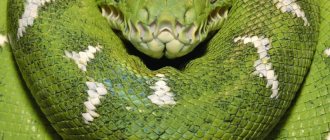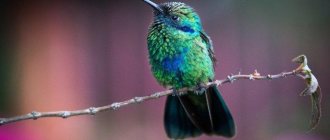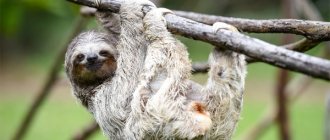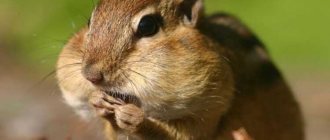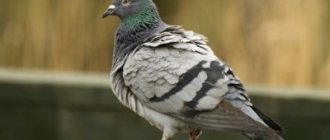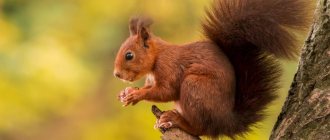The common snake, from the Latin "Natrix natrix", belongs to the snake family. There are several subspecies of this reptile, which differ mainly in color and size. In Russia this is one of the most famous snakes. Unfortunately, snakes are very rare, and not only because they are asocial individuals.
In this article we would like to introduce you to this extremely interesting and widespread snake in Russia. To do this, we will look at its appearance, tell you where the snake lives and how it feeds. We will also talk about its distribution and why it is endangered in Europe.
Distinctive features of the common grass snake
A typical identifying feature of the common grass snake is the two bright, crescent-shaped spots that are located just behind the head on the neck. They are mostly yellowish, orange or white and lie on the neck like a crescent moon.
The color of their scales can be varied. Snakes range from reddish-brown to olive in color. Sometimes you come across individuals that are completely black. The snake's body is decorated with dark spots. Typically four to six rows. The lower part of the body is grayish-white and also decorated with dark spots. The tail is pointed, the head is oval, the eyes are large, with huge, black, round pupils.
The reptile reaches a length of up to 1 meter. Females are slightly longer and thicker than males, and can sometimes reach a length of up to 1.30 m, in more rare cases even up to 1.50 m.
Skids
These are large snakes, reaching sizes of two or more meters in length. There are also several dozen species of them. They are also found in our country, especially in the south of the Far East. In the kingdom of snakes, snakes are excellent sprinters. Small individuals prefer to run away, but large ones can also show aggression towards humans. Although snakes are not poisonous, their large, dog-like teeth can cause wounds. The yellow-bellied snake is especially aggressive, which is found in Ukraine, in the countries of Transcaucasia and in our Lower Volga region up to the Ural River. When cornered, he gets right in the face. The spotted snake is not far behind him in his desire to stand up for himself. Its habitat is Central Asia. And the largest non-venomous snake (unless, of course, you count pythons and boas) is the big-eyed snake. It reaches a length of three and a half meters.
Habitat
Snakes are found in a variety of waters. This is an ideal environment for them to live. Snakes love running water, lakes, ponds or swamps with lush vegetation for protection from predators. They are often found in sand and pebble ponds, as well as in garden ponds in cities. Snakes prefer dry places during mating, for hibernation and for laying eggs.
They can also live in areas away from water, such as forests or forest edges, parks, etc., but this is not their preferred environment.
copperhead
This is a small one. The photo shows a red or brown snake only 50 cm long, which has small dark spots along its back. The copperhead lives in clearings and forest clearings, meadows and steppes. Its habitat is from Scandinavia and throughout Europe. Here it is found in the southern part of the country. Viperphobes mercilessly kill copperheads, confusing them with poisonous snakes. And in vain. Copperheads themselves eat viper pups, and sometimes attack adult individuals. However, they have poison. But it only affects cold-blooded people—the copperhead’s bite kills lizards in a matter of seconds. But for humans it is absolutely harmless. The false snakes of Latin America - mussurans - feed exclusively on poisonous snakes. This quality is used by farmers in Brazil and Argentina. They breed mussuran to protect their homes and herds from poisonous snakes, which are eaten by this false snake.
Nutrition and lifestyle
The snake feeds mainly on amphibians such as frogs, toads and newts. But its menu also includes fish, small birds, mice and lizards. While still young, it feeds only on tadpoles, larvae and very small frogs.
When searching for food, the snake recognizes its prey by smell, which it catches with its tongue and transfers to Jacobson's organ for analysis. Since some types of frogs can inflate, the snake attacks from behind so that they do not have time to do this. If the frog does not inflate, then the victim will be completely absorbed.
The snake prefers to be active during the daytime, especially during warm hours, when it can soak up the sun. In the evening he goes to his hiding place. Large stones or old tree trunks can serve as them.
Snakes spend a lot of time in the water and are excellent swimmers. Usually, when swimming, the head sticks out of the water.
Natural enemies
This is a very shy species of snake. Snakes try to escape as soon as they hear strangers' footsteps. They try to escape from predators as quickly as possible.
The snake's main enemy is, first of all, man. But he also has other, natural enemies who kill the snake in order to eat it.
These include birds of prey such as gray herons and mammals such as cats, foxes and weasels. During winter fasting, even rats can eat them. Young animals are especially dangerous, since a defenseless animal is a real treat for them.
If a snake feels threatened in the water, it quickly moves to land. If a predator has driven her “into a corner,” she tries to change from the position of a victim to the position of an attacker. She begins to hiss and rush at the predator, thereby trying to scare away or disorient the potential threat.
When the snake does not see a way out of the situation and flight does not bring results, it pretends to be a corpse. At the same time, blood often appears from her mouth. This position allows you to disorient predators that react to movement.
If all else fails, then the snake secretes a liquid for protection. It is released through the gonads. Has a very unpleasant smell.
On very rare occasions she bites. But its bites are absolutely safe for people and pets.
When is the right time to help your snake hatch?
Once your eggs are pressed together and have been developing for about 52 days, the hatching process can begin. All snakes develop differently, and some develop faster than others. In general, all of your viable eggs should begin to hatch within the same 48-hour period started by the first snake to hatch.
There may be an egg in your party that the snake cannot fit into, and this may cause you some anxiety. There really aren't any guidelines for when to help a snake hatch, but if the snake hasn't hatched yet and it's been 48 hours since the first snake hatched, help may be needed.
The baby snake may not be strong enough to break the shell on its own and may die, so if you want to help, you can make a small cut in the shell.
This can be dangerous if you cut the snake or damage the membranes (or yolk) that the snake uses to survive. Helping your snake hatch can be dangerous, but sometimes it is necessary to protect the life of a weak hatchling.
Pairing
After hibernation, which takes place from October to April, molting initially occurs, and only then mating. One female is often claimed by several males, who try to attract attention by twitching movements and approaching the female. Fights between males usually do not occur. If the male has gained the female's favor, they mate. At the same time, his sexual organ penetrates the female and swells greatly, which leads to the closure of their bodies. After this, the male begins to move, and the female simply drags behind him like an extra shoot.
What is the body symmetry of a snake?
In Typhon, bilateral symmetry is manifested not only in the structure of the human body, but also in the arrangement of snakes, which at the same time retain their own bilateral symmetry.
Interesting materials:
How to copy a GIF to your phone? How to copy a picture from a pdf to Foxit Reader? How to copy music from Apple Music to a flash drive? How to copy an object in Illustrator? How to copy a link on your computer? How to copy a link to an application on Google Play? How to copy a YouTube playlist link? How to copy your VKontakte link? How to copy selected files? How is the speed of a wave related to the wavelength and its frequency to the wavelength and period?
Offspring
About two to three months after mating, the female lays 10 to 35 eggs in warm, sheltered areas. For this purpose, she chooses shelters such as old tree trunks, reeds or compost heaps.
Mass oviposition also occurs very often. This causes the females to lay their eggs in one pile. Therefore, there are often nests in which 100-200 eggs are collected together. They are usually 25-40 millimeters long and 15-20 millimeters wide.
Within a month, offspring appear. For its birth, the ambient temperature must be around 28 C. If there are bad weather conditions, the hatching period may increase to 60-70 days.
Small snakes are usually born in early autumn. The egg shell is cut with the so-called egg tooth. In the first year of life, young individuals stay overnight in their nest. After four years he becomes an adult. On average, the lifespan of these reptiles is 20 years.
How to set up a terrarium
If you decide to place a snake in your home, you must be prepared for the fact that you will need to create for it all the conditions necessary for its existence. Many people ignore advice on caring for reptiles, and as a result, their pets simply die. In order for an ordinary one to feel comfortable in your terrarium, it must be equipped according to all the rules.
For such a non-venomous snake, you will need a spacious and long terrarium, since you will need to place a large pool in it. Such a bath should be quite large so that the pet can fit completely in it. So most of the snake’s house will be occupied by the pool; it will not be able to live without it, since it needs to bathe and drink water often.
The bottom of the terrarium is covered with peat or sand, the main thing is that this soil retains moisture for a long time. It is necessary to place moss in the corner so that the snake can burrow into it and rest. In a place free from the pool, driftwood, branches or scattering stones are placed. The top of the terrarium should be tightly closed with a mesh so that the nimble pet cannot escape from its house.
Their protection and protection
They stay close to water because frogs are their main source of food. But the habitats of these reptiles are increasingly being destroyed by people. Existing pastures are converted into economic land. More and more wet areas and swamps are being depleted for the construction of buildings and highways. This greatly reduces the habitat area of these snakes.
In addition, every year there are fewer and fewer small bodies of water, such as ponds or lakes, which also destroys the animal’s habitat.
They are also faced with the fact that every year there are fewer and fewer good places for laying eggs.
We recommend reading: » «
Many snakes become victims of traffic during their migration. Or, people just kill them for fun.
Thus, it is not surprising that this species is on the Red List in most European countries.
In the European Union it is prohibited to kill them, as well as to catch them for home terrariums.
Also, special places and reservoirs are created for their egg-laying and hunting.
There are animals in nature whose very name evokes a feeling of fear. Snakes... Anaconda, boa constrictor, python, poisonous viper - these reptiles are known as animals that can inflict a fatal blow on humans. But even among this class of animals there are exceptions that are absolutely safe for people. We are talking about snakes. These representatives of the squamate order, the colubrid family, are considered one of the most harmless reptiles. A common one and a photo of the viper’s twin in this article.
The common one is the most common representative of its genus.
Physiology of male and female
It is almost impossible to distinguish a male from a female by external signs. The only external sign is that the females of most species are smaller than the males and are not as brightly colored. But for example, the female anaconda is larger than the male, so size is not an accurate sign for determining sex.
The sexual characteristics of snakes are hidden inside the body. The male's paired fertilization organs, the hemipenises, are hidden in special pockets in the abdominal cavity, closer to the tail. In the presence of a female who is ready to mate, the hemipenes enlarge and become ready for mating.
It is noteworthy that only one of them is used during mating. But if there is another lady nearby, then there will definitely be an opportunity to use the second one.
Important!
During the breeding season, snakes are most aggressive, and the female’s attraction of many males from throughout the surrounding area makes a chance encounter with reptiles even more dangerous.
The female's paired genital organs, the hemiclitors, are not visually visible and are located inside the body. The readiness of a female to mate is indicated by the pheromones she secretes. The male is able to sense them from a distance of several kilometers.
Distinctive external features of common grass snakes
This species of snake is considered one of the largest of its kind. The average body length of an adult reaches one meter, but scientists have discovered a grass snake that has grown to 2 meters!
The most common color among snakes is black with two yellow spots on the sides of the head (“yellow ears” is what these spots are also called). It is these “yellow ears” that are a distinctive feature: they are the only way to distinguish a snake from a snake. Sometimes the color is different: there are individuals of a gray hue with light stripes or spots arranged in a checkerboard pattern. There are two large eyes on the animal's head.
How to distinguish a snake from a viper
The two bright orange or yellow spots on the sides of the head are not the only distinguishing mark. Snakes, at least real ones, snakes, as well as some false ones, have round pupils. Whereas in vipers they are slit-shaped, vertically located. Again, this difference is the rule only in our country. In the tropics, snakes with slit-like pupils are found. The color of the viper - black or dark gray - can be found on the backs and sides of its non-venomous counterparts. So what types of snakes are found in our country? The most common in the European part of Russia is Natrix. The northern border of its range is the latitude of Vologda. The merman is more thermophilic. Here it is found only in the southern Volga region, Kuban and the Don. And finally, Rhabdophis tigrina, the tiger snake, is found in the Primorsky Territory. This species is worth special mention. This is roughly 110 centimeters long. If it happens to bite a person with its short front teeth, the wounds are small and no symptoms of poisoning are observed. But it is not recommended to put your finger in a tiger snake’s mouth—literally. In the depths of its throat (on the back of the upper jaw) there are also poisonous teeth. The secretion causes poisoning, not inferior in severity to the consequences of
Lifestyle of an ordinary snake
Among natural habitats, common grass snakes choose wet areas. They settle near lakes, ponds, near rivers, in reed thickets and swamps. But there have been cases when an ordinary snake was encountered in the steppe area and even in the mountains.
Snakes are not afraid of being close to a person and therefore can crawl into a house or outbuilding absolutely calmly. When caught by a person, it begins to hiss and throw its head forward, and may even bite; however, these bites are not terrible for humans and are absolutely safe. The rest of the time it is not an aggressive animal at all.
These reptiles can float well in the water and swim quite quickly; their body wriggles in the water in the same way as when moving on land.
They are most active during the day or at twilight. Snakes live quite a long life - up to 20 years.
Types of snakes
As already mentioned, this is a very large family. It is divided into three groups: real snakes, false snakes and snakes with copperheads. Let's first look at the genus Natrix. These are real snakes. There are also several hundred species of them. The most common of them is Natrix natrix, or ordinary. It is found throughout Europe (except the Far North). It is from this appearance that we form an idea of what it is. The photo of this small snake with yellow “ears” serves as a kind of “photo identikit” of the whole family. Wrong opinion! There are species of snakes without yellow spots - for example, Natris tesselata, which lives in the reservoirs of Western Europe, Moldova and Ukraine. Not to mention snakes, quite large snakes, and copperheads. But they also belong to snakes. There are also poisonous species among this diverse family. It’s just that their secretion is not dangerous to humans and, in the worst case, can only lead to swelling around the bite site.
Breeding snakes
The mating season for these reptiles begins in the spring. One female attracts several males, all applicants intertwine with the female into one ball. The winner in this mating competition is the most dexterous male, who prevented everyone else from taking possession of the female.
After mating and fertilization, the female lays eggs. The average number of eggs in one clutch is 30 pieces. Future offspring are deposited in a warm, secluded place - heaps of leaves, sawdust, etc.
This is really
A month later, two of the eggs appear, small ones. Their body length at birth ranges from 14 to 22 centimeters. Baby snakes feed on small frogs, and in all other respects they behave like fully grown snakes. The coloring of babies is also no different from adults. Already in the third or fourth month of age, the Ugata babies become fully adult individuals and can themselves engage in breeding offspring.
And this is a poisonous viper. As you can see, you can distinguish a snake from a viper only by its orange-yellow ears
Pregnancy and birth of the brood
Pregnancy lasts an average of three months. Snakes lay eggs under lying objects, tree roots, in empty holes, manure or in rotting plant debris. The amount of harvest depends on the size of the female. A snake up to 70 cm long lays about 10 eggs, more than a meter - 15-30. Inside the shell there is a large yolk surrounded by a thin layer of white. The eggs of the common grass snake resemble those of a pigeon. But they are held together “in beads” by a gelatinous substance. Three weeks pass between the periods when snakes lay eggs and when the young emerge. Newborns are 15 centimeters in length, but are already fully viable. They feed on worms, snails and various insects. Young animals are easily tamed and take food from their hands.
About two-thirds of all snakes living on the planet belong to the colubrid family. Currently, there are about one and a half thousand varieties, each of which has its own distinctive characteristics.
Despite the striking similarity between the snake and the viper
common, thanks to which many people fall into a stupor at the sight of this completely harmless reptile, they differ from their poisonous relatives in their peaceful and calm character.
snake snake
many years ago it was customary to keep cats as pets, since they are often superior to four-legged animals in catching other rodents.
In steppe and mountainous areas, snakes are also frequent residents, where they can be found at an altitude of up to two and a half thousand meters. Since these reptiles are not afraid of people, they can also settle in unfinished buildings, basements, waste dumps and even in vegetable gardens.
Snakes usually do not make well-equipped burrows, and their shelter in the dark can be the roots of large trees, piles of leaves and branches, as well as haylofts and crevices in buildings. In soft ground, they can make relatively long passages on their own.
In winter, they prefer to move to more reliable places, such as burrows of all kinds of rodents and outbuildings made by humans. Some snakes wait out the winter period alone or in small groups, but most individuals gather in mass gatherings for wintering together with vipers.
There have been cases when snakes, waiting out the cold in the basements of residential buildings, made their way directly into apartments due to exposure to especially low temperatures and even crawled into people’s beds.
Enemies of snakes
Since snakes are non-venomous snakes, they are a very attractive and tasty food for some birds: storks, for example, or other birds of prey. In addition, snakes are often hunted by some mammals. An owl, a wolf or a fox would not mind trying this reptile for lunch.
Even in the century before last, an ordinary person could live calmly in a peasant’s yard and not fear for his life. The villagers were afraid to kill the uninvited guest, thinking that they would bring trouble to their home.
Many people are still afraid of the common snake, considering it dangerous
It is considered a snake belonging to the class of reptiles. Most people are afraid of snakes, but is it dangerous?
Characteristics of the common snake
Almost two-thirds of the snakes on the planet belong to the colubrid family. Today there are about one and a half thousand different species, and each of them has its own distinctive features.
And although the common viper and the common viper are very similar, the former differs from its poisonous relative in its peaceful and calm character.
Snakes used to be kept as pets instead of cats because they were better at catching mice and other rodents.
A couple of hundred years ago in Ukraine there was a belief that if you offend a snake, you will suffer bad luck. The name of the city Uzhgorod also speaks about the popularity of snakes.
, located in western Ukraine, which has remained untouched to this day.
Distinctive features
The difference between ordinary snakes and other snakes is their “yellow ears,” pronounced markings on the head, most often yellow, but sometimes white and orange. It is extremely rare that marks are absent or weakly expressed. Females are larger than males. As a rule, the length of the snake is one meter, but there are individuals that reach a length of one and a half meters.
The reptile has dark gray, black or light gray skin. On individuals with gray skin, dark spots are very noticeable. On the light belly there is a dark stripe from the tail to the neck. The snake has round eyes, but there are individuals with a “cat-like” cut. The tail is 3-5 times shorter than the body and has a varied shape - sharp, steep, rounded. Some reptiles have smooth skin, while others have prominent ribs.
The description would not be complete without mentioning the reptile's teeth. Located at the top of the mouth, some of them enlarge when the pharynx opens. There are reptiles with immobile small teeth, and some have bent teeth. The tongue is already forked.
Reptile diet and life expectancy
Sometimes the common one feeds on insects, small birds and mammals. Favorite food: various amphibians:
- tadpoles;
- lizards;
- newts.
But still, the most favorite delicacy is frogs, which reptiles hunt at any time of the day or night. Where there are many snakes, the frog population disappears.
The lifespan of a reptile in captivity is no different from how many years it lives in the wild. As at home, the reptile lives in freedom for almost twenty years. Keeping such a reptile at home is not a good option.
, in this regard, it will be better if you get a less dangerous pet.
Reproduction in the natural environment
Reptiles can swim well and can stay under water for more than half an hour. As a rule, the mating season takes place in the spring in April-May and very rarely in the fall.
The mating courtship of snakes occurs without any complex elements; in one clutch, the female brings from eight to thirty eggs. To hatch eggs, she chooses the optimal place, for example, a pile of dry leaves, peat or sawdust. The birth period of the offspring is from one to two months.
The mating season begins in the spring
Interesting facts about snakes
- In nature, two-headed snakes are quite often born. For example, every fiftieth newborn water snake has 2 heads. True, such individuals do not live long.
- He never shows his stomach to the enemy. You can see the color of the abdomen only during “imaginary death” or when removed from the shelter during wintering.
- Prey swallowed by a snake remains undigested in the stomach for some time, and if a caught snake regurgitates food in defense, then recently eaten frogs or fish remain alive and unharmed.
- There are many tales told about snakes: that the reptiles hypnotize frogs during the hunt or suck milk from the udder of a cow. In fact, this is fiction.
- The snake is a reptile that quickly gets used to humans. It is easy to tame. But keeping snakes at home is a troublesome task. It only eats living food, that is, food that moves. It is also difficult to maintain the desired temperature in the terrarium.
- Since ancient times, there have been many fairy tales and beliefs about these reptiles, according to which the snake is the keeper of treasures and treasures, the ruler of all reptiles.
- In the old days, in the villages of Ukraine, Belarus and the Baltic states, they lived in the house and caught mice just as well as cats. They were fed by deliberately leaving a jug of milk open. Already has always been a guard both as a magical symbol and as a rodent exterminator. Destruction or expulsion of the snake was considered unacceptable, as this threatened the house with misfortune.
Did you like the article? Share with your friends:
Reptile-human contact
The reptile has acquired the title of a good-natured animal, because it very rarely uses its teeth against humans, and besides, it gets along well with other animals.
The snake is easy to tame and does well in captivity. Having noticed a person, he tries to run away
, and when he is caught, he actively defends himself: he begins to hiss and throw his head forward. If this does not help, he secretes a thick, foul-smelling liquid from the cloacal glands and pretends to be dead. Such imaginary death is a defensive reaction of the reptile. If the reptile is left alone or placed in water, it comes to life. The pungent and foul-smelling liquid kills the appetite of four-legged predators.
It rarely bites, and its bite does not cause harm to a person, except for minor scratches.
The benefits and harms of snakes and vipers for humans
Snakes exterminate field and garden rodents. When kept in captivity, they are unpretentious in care and undemanding in food. Sensing danger, they do not attack the person, but try to hide. If it is not possible to disappear from the person’s field of vision, they take a defensive pose, hiss and make short lunges towards the threatening object. If the danger has not disappeared, a strong-smelling enzyme is released to scare off the enemy.
The viper is dangerous with its poisonous bites, but when frightened, it will not rush at a person first if it had no intention of attacking. When threatened, this snake curls up into a ball, extends its neck and hisses, opening its mouth wide and rotating its jaw so that its fangs become visible. Almost always, a viper bite takes the life of a small animal. For humans, in most cases, a bite does not end in death. Medicines are made from viper venom and used in folk medicine.
Dangerous Enemies
Before the sun sets, the reptile must hide
, otherwise it will quickly cool down and will not be able to quickly hide from its enemies, and it has many of them:
To frighten its enemies, the reptile hisses and, pretending to be a poisonous snake, flattens the neck area, its body folds in a zigzag, and the tip of its tail twitches nervously. There is another option for salvation - he is trying to escape.
Such a number of enemies and dangers significantly affects how long a snake lives in the wild. Reptiles have a constant shortage of reliable, good shelters, so they take great pleasure in inhabiting human houses, chicken coops, bathhouses, basements, sheds, bridges, garbage dumps and compost heaps.
A common inhabitant of wet places, swamps and river banks in our country, it is found throughout almost the entire European part of Russia, as well as in the south of Siberia and the Far East.
Description of the snake
The animal is already ordinary
belongs to the genus of real snakes and has a distinctive feature in the form of two “ears” on the head - spots of white, yellow or orange. In some individuals, the spots are weak or absent. The coloring of snakes ranges from black to gray or brown with a lighter belly, the presence or absence of a pattern in the form of spots or stripes. Source:
The snake is diurnal, and its activity is subject to seasonal changes. Snakes are most active, including the breeding season, from April to September. In the morning they crawl out to warm up in the sun, and at night they cool down in shelters made of branches, under snags, leaves, etc. In winter, they hide in shelters and hibernate. Females are larger than males, snake length
can reach 1.5 meters.
Like other snakes, grass snakes shed their skin. During normal molting, the skin comes off entirely. Before molting, it becomes more passive and refuses food. To ensure easy molting, you need to maintain a sufficient level of humidity.
Generally speaking, it’s hard to call a snake a pet, and considering that most of the snakes on the same poultry market are caught in the wild, it’s not very advisable to take this snake home. After all, no matter how good the conditions of detention, they cannot be compared with the natural habitat. In addition, snakes are quite demanding in terms of temperature and humidity, so they often die in inexperienced hands. If you have no experience with snakes, it is better to release the snake into the wild.
Terrarium for snake
have a snake at home at any cost
, then for home maintenance he needs a spacious long terrarium, a significant part of which will be occupied by a swimming pool. A snake needs a pool for swimming and drinking, so choose a body of water that your pet can fit in completely.
The top of the terrarium is tightly closed with a net to prevent it from escaping. A soil that retains moisture well: peat or sand is placed at the bottom of the terrarium. You can also place sand at the bottom of the pool. Source:
In addition to the main soil, create an area of damp moss in a warm corner in which your snake can burrow. They also place all kinds of snags, scatterings of stones between which the snake can crawl, shelters and shelters made of well-fixed branches or bark.
It is necessary to maintain a temperature difference in the terrarium. One corner should be warm for warming up. A heating lamp is placed near it, under which you can put a stone or driftwood, where the snake will heat its body. It is also better to place the area with wet moss in a warm corner. Daytime temperatures here should be 30-35º.
In addition to the warm corner, there should be a cool and dry place, preferably with a shelter, where it can cool down. In this place the temperature is about 22º. The average temperature of the rest of the terrarium during the day fluctuates around 22-26º. At night, the terrarium is not heated or lit, because... It is already active during the day and sleeps in a shelter at night. In addition to temperature, it is necessary to maintain humidity in the terrarium. To do this, the soil and moss are regularly sprayed. It is very good to purchase a special lamp with ultraviolet light, although in the summer you can limit yourself to regular sunbathing.
Domestic snake and hibernation
In order for it to hibernate, in the fall the daylight hours are reduced for a month (gradually, from 12 to 4 hours) as well as the heating period. A decrease in temperature and lighting provokes hibernation, therefore, after a complete cessation of lighting and a decrease in temperature to 10º, it is able to spend about 2 months in hibernation, which has a beneficial effect on further activity and reproduction.
Where and how do snakes winter?
The vital functions of reptiles slow down with the arrival of cold weather, and in the fall the snakes hibernate. They can sleep for 8 months a year. But if spring is early and warm, and autumn is late, then the period of hibernation is reduced. For wintering, snakes choose secluded places that do not freeze during frosts. Several dozen individuals often gather in such shelters. Sometimes other types of snakes spend the winter next to snakes. With the onset of warmth, snakes wake up, crawl to the surface and bask in the sun, and after a few days they crawl out of their shelters.
Photo credit: Aiwok, CC BY-SA 3.0
Feeding snakes
What do snakes eat? The snake's diet consists of live food. Snakes feed mainly on frogs and rodents, sometimes small fish. Food must move! At home, you will have to buy tree frogs, small mice, aquarium fish and feed them alive. Also, some snakes eat insects, bloodworms, snails, and worms.
Already
- a snake belonging to the class of mammals.
Many of us are terribly afraid of snakes, but should we be afraid of an ordinary snake
? Is it dangerous for humans and does it have poison? Today we will answer these questions, and also touch upon the snake’s habitat and find out what it eats in nature, and we will start with its characteristics.
Description of a common snake
Snake length
1 meter, but some individuals grow up to 1.5 meters.
Its main and characteristic feature
is bright spots on the back of the head.
They can be orange, yellow and whitish. Quite rarely, only black snakes or faint spots are found, so it is quite easy to recognize the snake. The skin
of the snake is dark gray, black or light gray.
Gray individuals may have dark spots. belly
is light with a dark stripe from the tail to the neck.
The body of the snake
is slender, and on some individuals you can see paired brushes, but not on all.
eyes
are round, but there are snakes with “cat eyes.”
The tail
is much shorter than the body, about 3-5 times, with a varied shape - sharp, steep, rounded.
Scales
are visible throughout the body , some individuals have smooth skin, others have visible ribs.
The snake has teeth on the top of its mouth, several teeth increase along the opening of the pharynx, some have teeth
, others have them bent, and also have a forked
tongue
.
The lifespan of an ordinary grass snake
in nature is about 20 years; at home, the figure remains the same.
Is the common snake poisonous and is it dangerous for humans?
Overall, snakes
safe for humans.
They do not know how to bite, but can scratch the skin, and if there is a bite, it is insignificant. And an ordinary snake
, when it sees a person, tries to hide as quickly as possible; it flees and does not attack.
But if they are caught by surprise, they hiss and turn their heads as if they want to bite, but they rarely get bitten, and the bite itself heals very quickly. snake
is a calm snake, but for the purpose of protection, it can shoot a white-yellow liquid from its teeth, which has an unpleasant odor, and if it does not scare away the observer, it opens its mouth and relaxes its body, feigning death.
At this moment, you can see drops of blood from the throat, or he will simply regurgitate food out of fear. But if you
don’t touch it, you won’t have to see all this.
Why know what it looks like?
This snake can be found everywhere, even in a village house. In order not to confuse it with a viper, you need to imagine what it is like. It is also advisable to know what a snake bite looks like. After all, after a person is bitten by a viper, his life is in danger, and he definitely needs medical help. And it’s not poisonous; usually it only scratches the skin with its teeth. This is quite painful, but not dangerous. To avoid trouble, it is better not to come close to any snakes at all, but try to avoid them.
WHAT DOES THE COMMON SNACK EAT, WHERE DOES IT LIVE AND KEEPING AT HOME?
What does the common grass snake eat in nature?
Snake's main diet
- amphibians and fish.
It feeds on frogs, tadpoles, and toads. In addition, snakes eat lizards, their eggs, mice, rats, moles, other rodents, insects, small birds, their eggs and chicks, bats, small squirrels, and even their own kind or other snakes. The grass snake
swallows its prey whole because it does not have teeth or other devices to tear its prey.
If the lunch is small, then he will quickly finish the meal, but if the prey is large, he will have to deal with it for several hours, and after such a meal he can go without eating anything for two days. It can go without food for a long time, but it cannot live without water, and in hot weather it is easy to find it near bodies of water. On
land it stalks its prey, in water it can sneak up on it for a long time, and then suddenly pounce.
Habitat of the common grass snake
Snakes can be found
near bodies of water, under a bridge, near a lake or pond.
In addition, they like to settle next to people, choosing quiet and secluded places such as a basement, haystack, cellar, barn, in the roots or hollows of trees, in the garden, in firewood, in a pile of stones, in a vegetable garden and even in a pile of garbage . Snakes
love warm bedding and live next to poultry, laying their eggs there, but they will never go to large animals.
Habitat of the common grass snake
– almost all of Russia, eastern Primorye, the borders of the Komi Republic, the border of Karelia.
Almost all of Europe, and some snakes also
found in Africa, Central, South and North America, Australia, Asia, Cuba, Indonesia, the Philippines, Japan, and Oceania.
Where do snakes live?
Snakes inhabit the territory of almost all of Europe up to the Arctic Circle, live in Africa in its various parts, excluding the most arid places and deserts, and are found in North and Central America, in Cuba. Reptiles also occupy a significant part of Asia, in addition to the northern territories, they live on the Japanese, Philippine, islands of Indonesia and Oceania. There is one species in Australia. In South America, where there are no snakes, they are replaced by a very close genus of cross-eyed snakes. In Russia, grass snakes live throughout almost the entire European part, right up to the borders of the Komi Republic and Karelia, and spread to the east to Primorye.
Snakes live wherever it is humid and there is water. Depending on the species, these snakes can live in the steppes, in the mountains, near the sea, in floodplains of rivers, near lakes and ponds, in swamps, in thickets of reeds and bushes, in forests, in floodplain meadows. Also, among the wide variety of snakes, there are species that are completely unrelated to water and live in arid and sandy areas.
Photo by: Josef Němec ml.
As a rule, snakes are active during daylight hours. They usually hunt in the morning and evening, and bask in the sun during the day. These reptiles can climb trees well, moving from branch to branch, bathe a lot, swim and dive well, and can stay in water for a long time. Usually snakes swim along the shore of a reservoir without crawling onto land. However, cases have been described when snakes were seen in the middle of a large lake and even in the open sea, tens of kilometers from the shore.
Snakes swim in a characteristic way: they raise their heads above the water, and their body and tail wriggle in waves in a horizontal plane close to the surface of the water, leaving behind a wide strip of ripples. In addition, snakes can move under water and also lie on the bottom for a long time.
Photo credit: PeterZe, CC BY-SA 4.0
Some grass snakes are burrowing snakes that live on the forest floor and hide under rocks. For example, living in the desert areas of North Africa and South-West Asia, sharp-faced snakes burrow into loose soil and shovel sand onto themselves. These snakes are strictly nocturnal and only in the spring, after hibernation, come out during the day to bask in the sun. The main part hides in their shelters at night.
